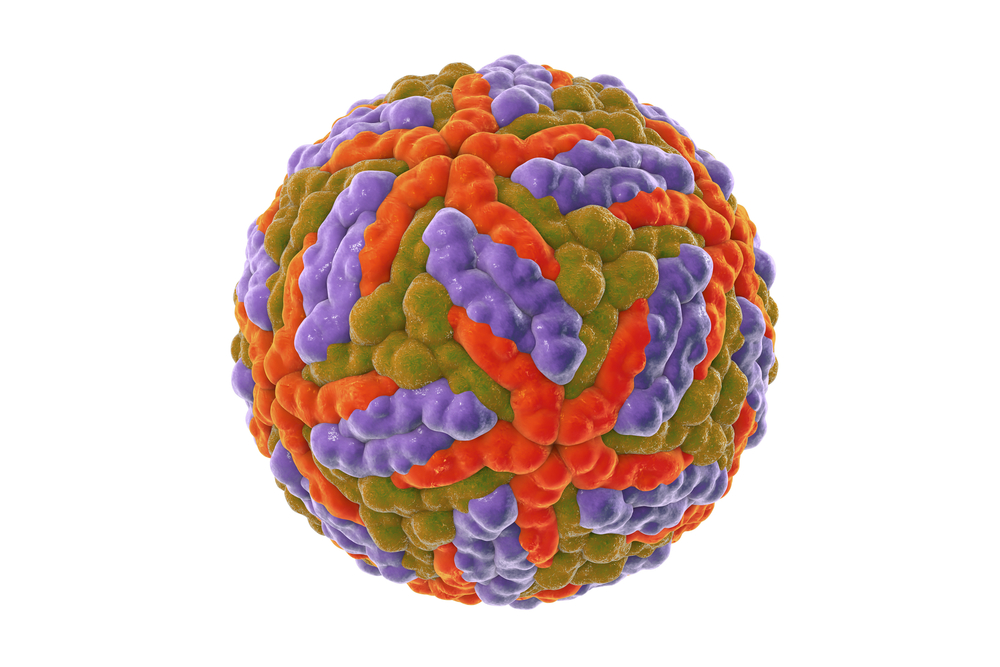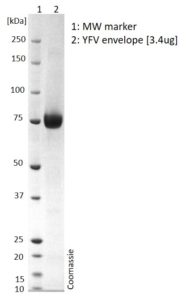SDS-PAGE : Coomassie-stained SDS-PAGE showing purified recombinant YFV envelope protein.
Yellow Fever Virus Envelope Protein, Sheep Fc-Tag
$872.54 – $3,708.33 excl. VAT
This Yellow Fever virus Envelope protein with sheep Fc-tag has been manufactured in insect cells in response to the need for a highly purified, concentrated protein for use in further vaccine development and serological based diagnostic assays.
YELLOW FEVER VIRUS ENVELOPE PROTEIN, SHEEP FC-TAG
This Yellow Fever virus Envelope protein has been manufactured in insect cells in response to the need for a highly purified, concentrated protein for use in further vaccine development and serological based diagnostic assays.
PRODUCT DETAILS – YELLOW FEVER VIRUS ENVELOPE PROTEIN, SHEEP FC-TAG
- Recombinant Yellow Fever virus Envelope protein (NCBI accession number AWB15005, AA287-679) produced in insect cells.
- Protein contains a C-terminal sheep Fc-tag and is purified from culture supernatant by Protein G affinity chromatography.
- Presented in Dulbecco’s phosphate buffered saline (DPBS) pH 7.4.
BACKGROUND
Translation of the positive-stranded viral genomic RNA in infected cells results in the synthesis of a polyprotein precursor of 3411 amino acids, which when proteolytically processed, generates 10 viral proteins. These are (from the amino- to carboxi-terminus of the precursor polyprotein): C; prM/M; E; NS1; NS2A; NS2B; NS3; NS4A; NS4B and NS5. The first three are viral structural proteins that form the virus particle together with the RNA molecule, namely capsid (C, 12–14kDa), membrane (M of 8 kDa, its precursor prM of 18–22 kDa), and envelope (E, 52–54 kDa). These are encoded in the first quarter of the genome. The remainder of the genome encodes the non-structural proteins (NS), numbered from 1 to 5 (NS1 to NS5) in accordance with the order of synthesis.
E protein is required for receptor binding and viral attachment, fusion, penetration, hemagglutination, host range and cell tropism. It also has an important role in immunological anti-virus response, eliciting neutralizing antibodies and inducing protective response. Native E protein forms homodimers and it undergoes conformational rearrangement into a fusogenic homotrimer after entering cells by receptor-mediated endocytosis. This conformational change occurs in the lower pH environment of the endosome where viral lipid envelope fusion with endosomal membrane, releases the nucleocapsids into the cells cytoplasm. Each E protein monomer has a molecular mass of 50-55 kDa and has three distinct domains: domain I, II and III. Domain III is the immunoglobulin-like receptor binding domain and is recognized by virus-neutralizing antibodies, making it a target for diagnostic assays.
Yellow fever continues to be a public health concern inmany countries of Africa and the Americas. It is estimated that 200 000 cases and 30 000 deaths are attributable to yellow fever annually.


